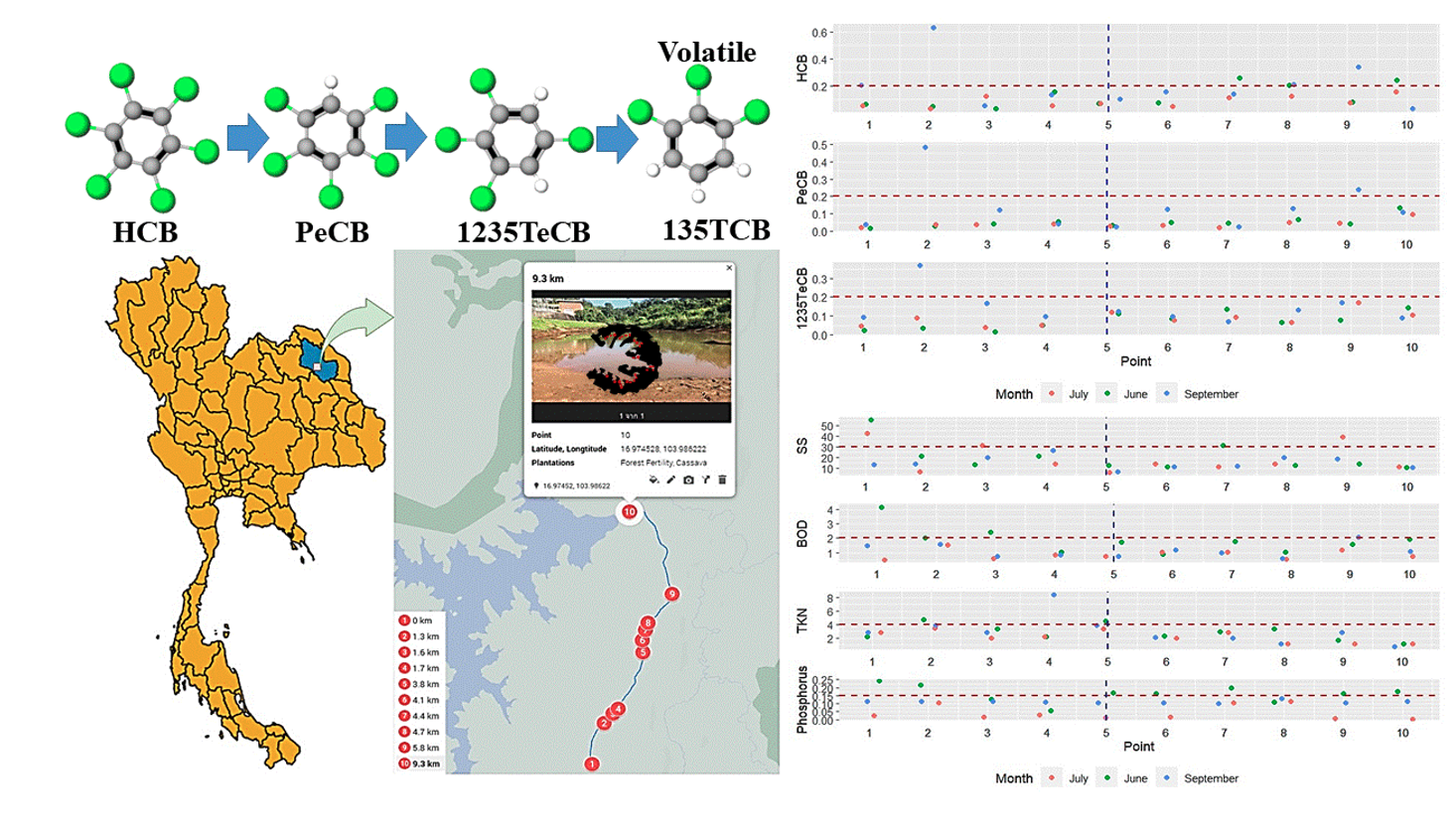Understanding the persistence of hexachlorobenzene and its intermediates in agricultural chemical usage areas
DOI:
https://doi.org/10.55674/cs.v16i3.253700Keywords:
Hexachlorobenzene (HCB), Pesticide, Persistence, Agricultural ChemicalAbstract
This study examined the presence and distribution of Hexachlorobenzene (HCB) and its derivatives in sediment samples. The investigation was conducted in a watershed along the Lum Stream agricultural area during the 2021 rainy season. The results showed HCB persistence despite being banned for a prolonged period. The water quality, indicated by the suspended solids (SS) and organic content, was evaluated at ten different observation points. However, only trace amounts of chemicals were detected in the sediment samples. The concentration levels of HCB, PeCB, and 1235-TeCB in the sediments ranged from 0.032 to 0.631 ppm, 0.018 to 0.485 ppm, and 0.091 to 0.366 ppm, respectively. The relationship between HCB, SS, and organic content was analyzed monthly, revealing interesting patterns. For instance, June and July exhibited similar trends, while HCB and its intermediates were negatively correlated with distance in September. Furthermore, a positive correlation was observed between 1235-PeCB and BOD of 0.48. This implies that as the amount of 1235-PeCB increased in the sediment samples, the BOD of the water also increased, suggesting a possible impact of 1235-PeCB on the water quality.
GRAPHICAL ABSTRACT

HIGHLIGHTS
- Persistent Organic Pollutants (POPs) have been detected in trace amounts over an extended period, constituting a part of the environmental compartment where they remain.
- The re-emergence of suspended solids in river water is likely to have a significant correlation with the concentration of Hexachlorobenzene (HCB) and its intermediary compounds.
References
P. Panuwet, W. Siriwong, T. Prapamontol, P.B. Ryan, N. Fiedler, M.G. Robson, D.B. Barr, Agricultural pesticide management in Thailand: Situation and population health risk, Environ. Sci. Policy. 17 (2012) 72–81. 10.1016/j.envsci.2011.12.005.
Where is Thailand’s use of pesticides in the world? (in Thai). Thailand Pesticide Alert Network: Thai-PAN, https://thaipan.org
/highlights/2426, 10 June 2022.
T. Hirano, T. Ishida, K. Oh, R. Sudo, Biodegradation of chlordane and hexachlorobenzenes in river sediment, Chemosphere. 67 (2007) 428 –434. 10.1016/j.chemosphere.2006.09.087.
J.L. Nelson, J.M. Fung, H. Cadillo-Quiroz, X. Cheng, S.H. Zinder, A role for dehalobacter spp. in the reductive Dehalogenation of dichlorobenzenes and monochlorobenzene, Environ. Sci. Technol. 45 (2011) 6806–6813. 10.1021/es200480k.
I.M. Chen, W. Wanitchapichat, T. Jirakittayakorn, S. Sanohniti, W. Sudjarid, C. Wantawin, J. Voranisarakul, J. Anotai, Hexachlorobenzene dechlorination by indigenous sediment microorganisms, J. Hazard. Mater. 177 (2010) 244–250. 10.1016/j.jhazmat.2009.12.024.
J.L. Barber, A.J. Sweetman, D. Wijk, K.C. Jones, Hexachlorobenzene in the global environment: Emissions, levels, distribution, trends and processes, Sci. Total Environ. 349 (2005) 1–44. 10.1016/j.scitotenv. 2005. 03.014.
S. Khan, S. Priyamvada, S.A. Khan, W. Khan, A. Yusu, Studies on hexachlorobenzene (HCB) induced toxicity and oxidative damage in the kidney and other rat tissues, J. drug metab. toxicol. 1 (2017) 1–9.
C.Y. Liu, X. Jiang, X.L. Yang, Y. Song, Hexachlorobenzene dechlorination as affected by organic fertilizer and urea applications in two rice planted paddy soils in a pot experiment, Sci. Total Environ. 408 (2010) 958-964. 10.1016/ j.scitotenv.2009. 10.031.
M. Dimova, G. Iutynska, N. Yamborko, D. Dordevic, I. Kushkevych, Possible processes and mechanisms of hexachlorobenzene decomposition by the selected Commonas testosteroni bacterial strains, Processes 10 (2022) 1–9. 10.3390/pr 10112170.
J. Anotai, W. Sudjarid, W. Wanitchapichat, I.M. Chen, Hexachlorobenzene dechlorination by enriched mixed cultures from Thai canal, Fresenius Environ. Bull. 19 (2010) 469–473.
H. Smidt, W.M. Vos, Anaerobic microbial dehalogenation, Annu. Rev. Microbiol. 58 (2004) 43-73. 10.1146/annurev.micro.58.03 0603.123600.
M. Kumar, D. Kumar, D. Kubendran, P. Kalaichelvan, Hexachlorobenzene-sources, remediation and future prospects, Int. J. Curr. Res. 5 (2013) 1–12.
W. Stuetz, T. Prapamontol, J.G. Erhardt, H.G. Classen, Organochlorine pesticide residues in human milk of a hmong hill tribe living in northern Thailand, Sci. Total Environ. 273 (2001) 53–60. 10.1016/s0048-9697(00)0084 2–1.
S. Mao, G. Zhang, J. Li, X. Geng, J. Wang, S. Zhao, Z. Cheng, Y. Xu, Q. Li, Y. Wang, Occurrence and sources of PCBs, PCNs, and HCB in the atmosphere at a regional background site in east china: Implications for combustion sources, Environ. Pollut. 262 (2020) 114267. 10.1016/j.envpol. 2020.11 4267.
C. Qu, S. Albanese, A. Lima, J. Li, A.L. Doherty, S. Qi, B. De Vivo, Residues of hexachlorobenzene and chlorinated cyclodiene pesticides in the soils of the Campanian Plain, southern Italy, Environ. Pollut. 231 (2017) 1497–1506. 10.1016/ j.envpol.2017.08.100.
S. Grainger, F. Mao, W. Buytaert, Environmental data visualisation for non-scientific contexts: Literature review and design framework, Environ. Model. Softw. 85 (2016) 299–318. 10.1016/j.envsoft.2016. 09.004.

Downloads
Published
How to Cite
Issue
Section
Categories
License
Copyright (c) 2024 Creative Science

This work is licensed under a Creative Commons Attribution-NonCommercial-NoDerivatives 4.0 International License.








